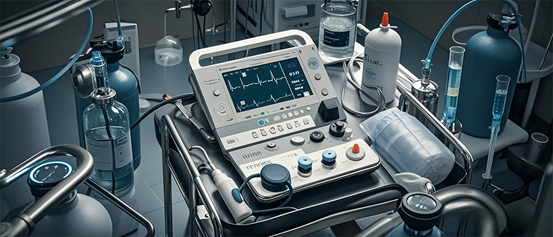Contents
- Key Takeaways
- Part 1: Types of Lithium Batteries for Medical Devices
- Part 2: Key Safety Considerations
- Part 3: Performance and Compatibility
- Part 4: Compliance with Medical Standards
- Part 5: Environmental and Physical Requirements
- Part 6: Cost and Budget Considerations
- Part 7: Testing and Prototyping
- FAQs

Selecting the right lithium batteries for medical devices is crucial for ensuring reliability and patient safety. These batteries power life-saving equipment, making the right choice a matter of precision and responsibility. You must prioritize factors like safety, performance, and compatibility to meet the unique demands of medical applications. Over 90% of FDA-approved devices rely on medical-grade batteries to comply with stringent standards and reduce risks. Adhering to certifications like UL2054 has significantly lowered safety incidents, while compliance with IEC 60086-4, IEC 60086-5 has decreased battery-related malfunctions by 25%. These statistics underscore the importance of choosing high-quality batteries to maintain device reliability and protect patients.
Key Takeaways
- Focus on safety features in batteries to keep patients safe.
- Pick batteries that follow rules like UL 2054, IEC 60086-4, and ANSI/AAMI ES 60601-1.
- Look at energy storage and lifespan to make devices work better.
- Work with trusted supplier like Large Power to get good batteries at a fair price.
- Test and try batteries to check if they work well in devices.
Part 1: Types of Lithium Batteries for Medical Devices

When selecting medical lithium batteries, understanding the different types available is essential. Each type offers unique advantages tailored to specific medical applications. Below, we explore the primary lithium medical batteries, rechargeable options and emerging technologies shaping the future of medical equipment.
1.1 Primary Lithium Medical Batteries
Primary lithium batteries are non-rechargeable and designed for single-use applications. These batteries are ideal for devices requiring long-term, low-power operation, such as implantable pacemakers and defibrillators. Their high energy density and reliability make them a preferred choice for critical medical applications. For instance, lithium thionyl chloride batteries provide exceptional shelf life and stability, ensuring consistent performance over extended periods.
Tip: Use primary lithium batteries for devices where recharging is impractical or impossible, such as implantable medical devices.
1.2 Rechargeable Lithium Medical Batteries
Rechargeable lithium batteries, particularly lithium-ion, dominate the medical device market. These batteries offer high energy density, lightweight design, and long cycle life, making them suitable for portable medical equipment like infusion pumps and defibrillators. In 2022, lithium-ion batteries powered 70% of newly manufactured medical devices, and this trend is expected to grow. They can handle over 500 charge cycles while retaining 80% of their capacity, reducing the need for frequent replacements.
- Key Benefits:
- Energy density up to 250 Wh/kg, significantly higher than older technologies.
- Long lifespan, ensuring reliability for critical medical applications.
1.3 Emerging Lithium Battery Technologies
The medical industry is witnessing rapid advancements in lithium battery types. Solid-state lithium batteries are gaining attention for their enhanced safety and energy density. These batteries eliminate the risk of thermal runaway, a critical safety concern in medical applications. Additionally, flexible lithium batteries are emerging as a solution for wearable medical devices, offering adaptability without compromising performance.
| Feature | Solid-State Lithium Batteries | Flexible Lithium Batteries |
|---|---|---|
| Safety | High | Moderate |
| Energy Density | Very High | High |
| Application Suitability | Implantable devices | Wearable devices |
The rise in home healthcare and telemedicine further drives the demand for innovative battery solutions. By 2025, these emerging technologies will likely redefine the landscape of medical lithium batteries.
Part 2: Key Safety Considerations
When selecting lithium batteries for medical devices, safety considerations play a pivotal role in ensuring device reliability and patient protection. Below, we explore the essential aspects of safety, including built-in features, thermal runaway prevention, and compliance with safety and performance standards.
2.1 Built-in Safety Features
Modern lithium batteries for medical devices incorporate advanced safety features to mitigate risks. These features include mechanisms to prevent overheating, short-circuiting, and leakage. For example, solid-state batteries have emerged as a safer alternative, with only a 1% ignition probability in accident scenarios compared to 10% for traditional lithium-ion batteries. Their thermal runaway threshold exceeds 200°C (392°F), significantly reducing safety hazards under extreme conditions. Additionally, these batteries generate fewer hazardous gases during failure, further enhancing their safety profile.
Tip: Always prioritize batteries with built-in safety mechanisms to minimize risks and ensure consistent device performance.
2.2 Thermal Runaway Prevention
Thermal runaway remains a critical concern in lithium battery applications. This phenomenon occurs when excessive heat triggers a chain reaction, leading to potential battery failure or fire. To address this, manufacturers design batteries with robust thermal management systems. Solid-state lithium batteries, for instance, eliminate liquid electrolytes, which are a common source of thermal instability. By choosing batteries with high thermal thresholds and advanced cooling technologies, you can prevent overheating and safeguard your medical devices.
2.3 Compliance with Safety Standards
Adhering to safety and performance standards is non-negotiable when selecting batteries for medical devices. Regulatory certifications like ANSI/AAMI ES 60601-1, IEC 60086-4, and UL 2054 ensure that batteries meet stringent safety requirements. For example, IEC 60086-4 focuses on leak resistance and stability, contributing to a 25% reduction in malfunction rates. Similarly, UL 2054 certification has led to a 40% decrease in safety incidents over five years. These standards not only enhance safety but also ensure the reliability of your devices in critical applications.
| Standard | Description | Impact on Safety |
|---|---|---|
| ANSI/AAMI ES 60601-1 | Governs medical electrical equipment, covering safety and performance. | Mandatory for many devices in the US and Europe. |
| IEC 60086-4 and 5 | Focuses on primary cell batteries, ensuring leak resistance and stability. | 25% reduction in malfunction rates due to battery failure. |
| UL 2054 | Ensures safety for lithium-ion batteries, preventing overheating. | 40% reduction in safety incidents over five years. |
By selecting batteries that comply with these standards, you can ensure both safety and regulatory approval for your medical devices. Large Power has decades of experience helping world-leading medical equipment providers obtain relevant certifications.
Part 3: Performance and Compatibility
When selecting lithium batteries for medical devices, understanding their performance and compatibility is essential. These factors ensure that the batteries meet the operational needs of your devices while maintaining reliability and safety.
3.1 Energy Density and Longevity
Energy density and longevity are critical performance requirements for lithium medical batteries. High energy density allows batteries to store more power in a compact size, which is vital for portable and implantable medical devices. Lithium-ion batteries, for instance, can achieve energy densities up to 250 Wh/kg, significantly outperforming older technologies like NiMH. This makes them ideal for devices requiring extended operation without frequent replacements.
Longevity is another key factor. Many lithium battery types are rated for over 500 charge-discharge cycles while retaining 80% of their original capacity. This long service life reduces maintenance costs and ensures consistent performance over time. For medical applications, where reliability is non-negotiable, these attributes make lithium batteries indispensable.
Tip: Choose batteries with high energy density and long service life to optimize device performance and reduce downtime.
3.2 Voltage and Current Requirements
Matching the voltage and current requirements of your medical devices with the battery is crucial for compatibility. Lithium batteries for medical devices typically offer stable voltage outputs, which are essential for sensitive equipment like infusion pumps or monitoring systems. Overloading or underpowering a device can lead to malfunctions or reduced efficiency. Always verify the battery capacity and ensure it aligns with the operational demands of your devices.
3.3 Integration with Medical Device Design
The integration of lithium batteries into your medical device design requires careful consideration. Factors like size, weight, and shape must align with the physical constraints of the device. For implantable devices, compact and lightweight batteries are essential to minimize patient discomfort. Additionally, the battery’s capacity and thermal management features should complement the device’s overall design to ensure safety and performance.
Collaborating with battery manufacturers like Large Power during the design phase can help you address compatibility requirements effectively. This approach ensures that the battery not only meets performance requirements but also integrates seamlessly into the device’s architecture.
Part 4: Compliance with Medical Standards
4.1 Regulatory Certifications
Regulatory certifications are essential for ensuring that lithium batteries meet the stringent requirements of medical applications. These certifications validate that the batteries comply with safety, performance, and reliability standards. For medical equipment, certifications like FDA approval and IEC 60086-4 are critical. They confirm that the batteries are safe for use in sensitive devices, including implantable medical devices.
You should prioritize batteries with certifications that align with your target market. For example, ANSI/AAMI ES 60601-1 is mandatory for many medical devices in the United States and Europe. This certification ensures that the batteries meet electrical safety requirements, reducing risks in critical applications. By selecting certified batteries, you enhance compatibility with regulatory frameworks and streamline the approval process for your devices.
Tip: Always verify the certifications of your chosen lithium battery types to avoid delays in regulatory approval.
4.2 Safety Testing and Validation
Safety testing and validation are non-negotiable steps in the selection process for medical batteries. These procedures assess the battery’s performance under various conditions, ensuring it meets the safety and reliability standards required for medical applications. Testing evaluates factors like battery capacity, thermal stability, and resistance to environmental stressors.
Manufacturers conduct rigorous tests to simulate real-world scenarios. For instance, they test batteries for their ability to withstand extreme temperatures, vibrations, and shocks. These tests ensure that the batteries can perform reliably in diverse medical applications, from portable medical equipment to implantable devices. Validation processes also confirm the battery’s compatibility with the device’s design and operational requirements.
You should collaborate with battery suppliers to review test results and ensure the batteries meet your specific needs. This proactive approach minimizes risks and ensures the safety of your medical equipment.
Part 5: Environmental and Physical Requirements

When selecting lithium batteries for medical applications, you must evaluate their environmental and physical requirements. These factors ensure the batteries perform reliably under diverse conditions and integrate seamlessly into medical equipment.
5.1 Temperature Range
Lithium batteries for medical devices must operate within specific temperature ranges to maintain performance and safety. Extreme temperatures can degrade battery capacity, reduce lifespan, or even cause failures. For implantable applications, batteries must function reliably at body temperature, typically around 37°C (98.6°F). Portable medical equipment, such as infusion pumps, often requires batteries that can withstand a broader range, from -20°C to 60°C (-4°F to 140°F). Always verify the manufacturer’s specifications to ensure the battery meets the operational temperature requirements of your devices.
Tip: Choose batteries with built-in thermal management systems to enhance safety and reliability in varying environments.
5.2 Size and Weight
The size and weight of lithium batteries directly impact their compatibility with medical equipment. Compact and lightweight designs are essential for portable and implantable devices. For example, wearable medical devices benefit from thin, flexible batteries that do not compromise patient comfort. Implantable applications demand ultra-compact batteries to minimize invasiveness. Collaborating with battery manufacturers during the design phase can help you select batteries that meet these physical constraints without sacrificing performance.
5.3 Durability and Resistance
Durability is critical for batteries used in medical applications. These batteries must withstand physical stressors such as vibrations, shocks, and pressure changes. For instance, batteries in portable medical equipment often face frequent handling and transportation, requiring robust designs. Resistance to moisture and corrosion is equally important, especially for implantable devices exposed to bodily fluids. Batteries with protective coatings and sealed enclosures can enhance durability and meet stringent FDA standards for medical use.
Note: Prioritize batteries tested for durability under real-world conditions to ensure long-term reliability.
Part 6: Cost and Budget Considerations
6.1 Initial vs. Long-Term Costs
When selecting lithium batteries for medical applications, you must evaluate both initial and long-term costs. The upfront cost of a battery often reflects its technology, capacity, and compliance with medical standards. While lower-cost options may seem appealing, they can lead to higher expenses over time due to frequent replacements or performance issues.
Long-term costs include maintenance, replacements, and potential downtime caused by battery failures. For example, investing in high-quality lithium-ion batteries with extended lifespans reduces the need for frequent replacements. This approach minimizes operational disruptions and ensures consistent performance in critical medical equipment. By considering the total cost of ownership, you can make informed decisions that align with your budget and operational goals.
Tip: Prioritize batteries with proven reliability and durability to optimize long-term cost efficiency.
6.2 Balancing Quality and Affordability
Balancing quality and affordability is essential when choosing batteries for medical devices. High-quality batteries often come with a higher price tag, but they deliver superior performance and reliability. For medical applications, where safety and functionality are paramount, compromising on quality can lead to significant risks.
To achieve this balance, collaborate with reputable suppliers like Large Power who specialize in medical-grade batteries. These suppliers can provide options that meet your performance requirements without exceeding your budget. Additionally, consider emerging technologies like solid-state batteries, which offer enhanced safety and efficiency at competitive prices. By evaluating the specific needs of your medical equipment, you can identify cost-effective solutions that maintain high standards of quality.
Note: Avoid selecting batteries solely based on price. Instead, focus on their ability to meet the demands of your applications while adhering to industry standards.
Part 7: Testing and Prototyping

7.1 Importance of Testing
Testing plays a critical role in ensuring the reliability and safety of lithium batteries used in medical devices. It allows you to evaluate the battery’s performance under real-world conditions, ensuring it meets the operational demands of your applications. Rigorous testing identifies potential issues, such as capacity degradation, thermal instability, or voltage fluctuations, before the batteries are integrated into medical equipment.
You should prioritize batteries that undergo comprehensive testing for compliance with industry standards. For example, tests for thermal stability and resistance to environmental stressors ensure the battery’s durability in diverse medical applications. These evaluations also verify that the battery can maintain consistent performance over its lifespan, reducing the risk of device malfunctions.
Tip: Collaborate with suppliers who provide detailed test reports to ensure the batteries meet your quality and safety requirements.
7.2 Prototyping for Custom Applications
Prototyping is essential when designing custom medical devices that require specialized battery solutions. It allows you to test the integration of the battery with the device’s design, ensuring compatibility and optimal performance. During prototyping, you can assess factors like size, weight, and thermal management to ensure the battery aligns with the device’s physical and operational requirements.
For custom applications, working closely with battery manufacturers during the prototyping phase is crucial. This collaboration helps you identify potential design challenges early and refine the battery specifications to meet your needs. Prototyping also provides an opportunity to test the battery’s performance in simulated environments, ensuring it meets the stringent standards required for medical equipment.
Note: Prototyping reduces the risk of costly redesigns and ensures the final product meets both regulatory and performance expectations.
Choosing the right lithium batteries for medical devices requires careful consideration of safety, performance, compliance, environmental factors, and cost. These batteries play a vital role in ensuring the reliability of medical devices and the safety of patients. Thorough testing and adherence to medical standards are essential to avoid risks and ensure long-term functionality.
To make the best choice, prioritize safety features and compliance with industry standards. Collaborate with reputable suppliers who specialize in medical-grade batteries. Investing in high-quality batteries ensures durability and reliability, reducing the likelihood of device malfunctions. By following these steps, you can enhance the performance and safety of your medical devices.
FAQs
What is the most critical factor when selecting lithium batteries for medical devices?
Safety is the most critical factor. You must ensure the battery includes built-in safety features, complies with medical standards, and prevents risks like thermal runaway. These measures protect patients and maintain device reliability.
How do you determine if a lithium battery meets regulatory standards?
Check for certifications such as UL2054, IEC 60086-4, and ANSI/AAMI ES 60601-1. These validate the battery’s compliance with safety, performance, and reliability requirements for medical applications.
Can lithium batteries operate in extreme temperatures?
Yes, but only specific types. For example, Large Power offers low temperature lithium-ion batteries function between -40°C and 55°C. Always verify the manufacturer’s specifications to ensure compatibility with your device’s operating environment.
Are solid-state batteries suitable for all medical devices?
Not yet. Solid-state batteries excel in safety and energy density, making them ideal for implantable devices. However, their cost and limited availability may restrict their use in other applications.
How can you ensure the battery integrates seamlessly with your medical device?
Collaborate with battery manufacturers like Large Power during the design phase. This ensures the battery’s size, weight, and performance align with your device’s requirements, reducing the risk of compatibility issues.





